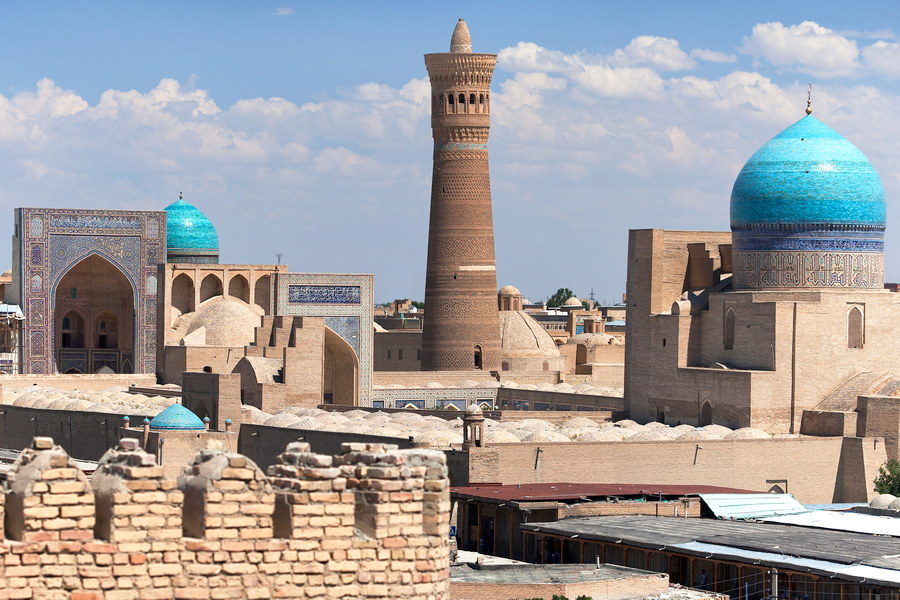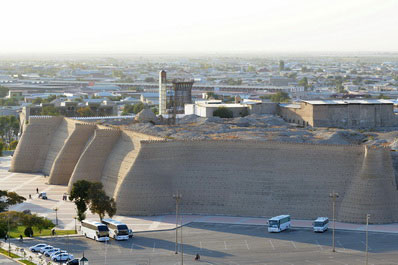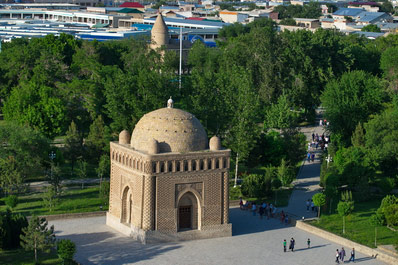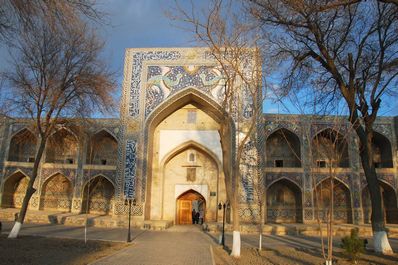Things to Do and Sightseeing Tours in Bukhara
Bukhara, situated in Uzbekistan, is among the oldest cities in Central Asia. In days gone by, the renowned Silk Road caravans traversed through this historic city. The ancient section of Bukhara has been recognized as a UNESCO World Heritage Site, attracting thousands of tourists from across the globe each year.
Today, Bukhara is a vibrant, thriving city with a population exceeding 275,000 residents.
Bukhara Tours
Bukhara tours invite travelers on a journey through time, revealing one of the most well-preserved medieval cities in Central Asia. With its dazzling array of mosques, madrasahs, and mausoleums, these tours offer a mesmerizing window into the region's past, from the awe-inspiring Ark fortress to the intricate design of the Miri-Arab Madrasah.
Before beginning your adventure, enrich your experience by familiarizing yourself with the profound history and enchanting tales of Bukhara.
History of Bukhara
Scholars believe that Bukhara was established around the middle of the first millennium BC. During archaeological excavations within the city, artifacts such as pottery, jewelry, and remnants of 5th-century BC structures have been uncovered.
The city of Bukhara was first mentioned between the 4th and 5th centuries on coins bearing its name. In the 7th century, the Chinese scholar and translator Xuanzang wrote about the city. The name "Bukhara" is derived from the Old Uighur language, meaning "prayer house" or "temple." However, various sources have referred to the city by different names, including Nyumi, Bukho, Buhe, Bukhala, Bumiskat, Fuho, and Anxi.
Throughout its history, Bukhara has been a coveted city for many rulers, changing hands from one conqueror to another. In pre-Islamic times, it served as a cultural hub for Central Asia.
During the 9th and 10th centuries, Bukhara became the capital of the Samanid Empire. Renowned figures, such as Abu Ali Ibn Sina, Abu Abdullah Jafar Ibn Muhammad Rudaki, Omar Khayyam, and others, lived and worked within its borders.
In the ensuing centuries, architectural brilliance flourished in Bukhara even as it ceased to be the capital. Numerous medieval structures have been preserved to this day. Under the reign of Tamerlane (Amir Timur), Bukhara began to emerge as a religious center, earning the moniker Bukhoroi Sharif, or Holy Bukhara.
Following the 1917 revolution, many historical edifices in Bukhara were demolished. By 1925, the city became part of the Uzbek SSR.
In 2020, the Organization of the Islamic World for Education, Science, and Culture designated Bukhara as the capital of Islamic culture.
Bukhara, Uzbekistan - Attractions
Things to Do in Bukhara
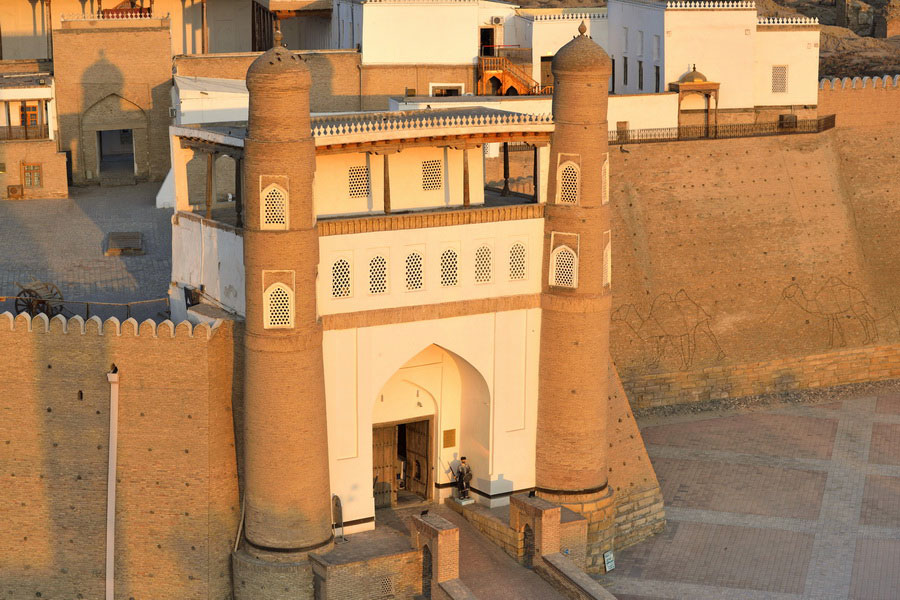
The ancient Ark fortress is one of the architectural symbols of Bukhara and the oldest monument of the city. This citadel is synonymous with impregnability and grandeur. Documentarily the fortress existed already in V century, and archeological excavations have confirmed that on this territory there was a defensive construction in IV century B.C. In VIII century the first city mosque was constructed here. On the territory of the citadel there was a palace, reception halls, hotels, library, mint, bath, prison and much more. Ibn Sino, Omar Khayyam and Rudaki all worked within the walls of the Arch. Today the Arch is a museum-reserve, where you can see how the rulers of the Middle Ages lived and the archaeological finds of scholars, as well as admire the oriental architecture.
Registan Square is not only in Samarkand. This square, the name of which is translated as "sandy place", is located near the Ark fortress. In the Middle Ages there were trading rows as well as administrative buildings and mosques.
Bolo Hauz is the only surviving complex of the Registan. It consists of mosque, minaret and hauz (pond). Mosque and hauz were built in 1712. After 200 years, a minaret was built next to the mosque.
Samanid Mausoleum serves as the burial site for the Samanid dynasty, who once ruled Bukhara. Constructed in the late 9th and early 10th centuries, it is the only surviving structure from that era. In 1993, the mausoleum was added to the UNESCO World Heritage List. Remarkably, the brick building has remained virtually unchanged for a thousand years.
Poi-Kalyan (Po-i-Kalan, or Poi Kalan) is an architectural ensemble located in the heart of Bukhara. Its name translates to "foot of the Great" or "foot of the Kalyan Minaret." The ensemble comprises the Kalyan Minaret (Kalon) at its center, the Kalyan Mosque and the Miri-Arab madrasa facing each other, and the Amir Alim-khan Madrasah.
Built in 1127, the Kalyan Minaret is a towering brick structure designed for Muslim clergymen to call the faithful to prayer from its summit. Standing at 46.5 meters tall, the minaret tapers upward from its 30.43-meter base. Its walls are adorned with geometric patterns and religious inscriptions.
Kalyan Mosque serves as Bukhara's primary Friday mosque, with the capacity to accommodate 12,000 worshippers simultaneously. Constructed in 1514, the current building replaced the original mosque that was destroyed by Genghis Khan's forces. The mosque features intricate decorations both on its exterior and interior.
Miri-Arab is a madrasah, an educational institution established in 1536. Until 1920, it was considered one of the finest in Central Asia, with many notable individuals teaching and studying within its walls. For instance, the first mufti of Ufa, Muhammedjan Husain, and the first mufti of Russian Muslims, Galimdzhan Barudi, were both graduates of this esteemed institution. However, following the 1917 revolution, the madrasah was closed and its clergy repressed. Believers campaigned for the resumption of educational activities after the Second World War, and between 1946-1956 and 1961-1989, the Miri-Arab madrasah was the only functioning madrasah in the entire Soviet Union.
Part of the Poi-Kalyan complex, the Amir Alim-khan Madrasah was founded in 1915. It was built using funds provided by Seyid Alim-khan, the last Emir of Bukhara. After all religious educational institutions were shuttered in 1924, the madrasah housed a library.
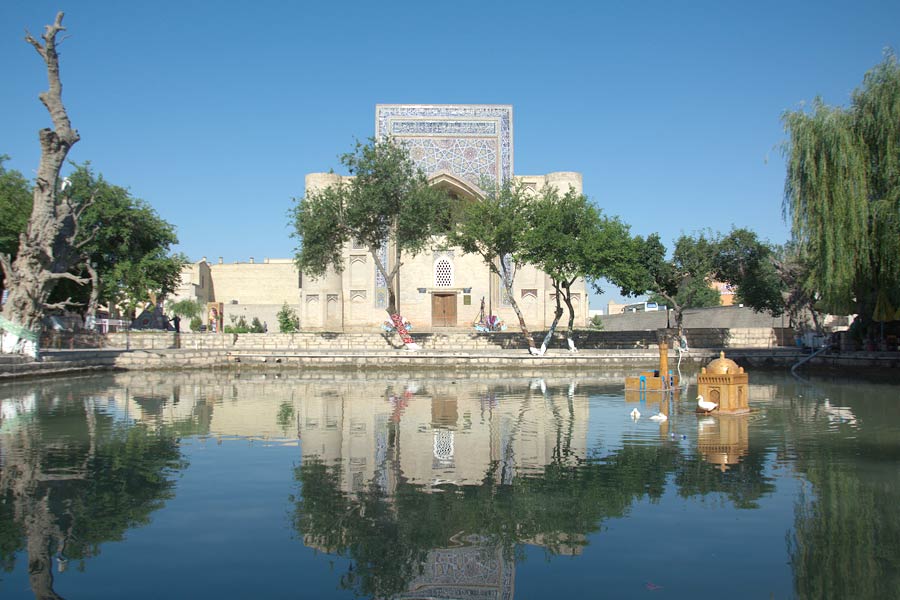
Lyabi-Hauz is one of the most popular spots in Bukhara, featuring a pond ("hauz" in Uzbek translates to "artificial water body"). Since the 16th century, Lyabi-Hauz has attracted numerous residents, as watermen once collected water from it for drinking and street watering purposes. Trade shops and teahouses were also situated near the pond. Today, as it has been for centuries, Lyabi-Hauz remains a central location in Bukhara. A monument dedicated to the renowned folklore character Hoja Nasreddin can be found nearby.
Founded in 1569 and situated close to the Lyabi-Hauz reservoir, Kukeldash Madrasah is currently the largest spiritual educational institution in Central Asia. Within its two-story structure, you can also find artisan workshops and souvenir shops.
Built in 1623, Nadir Divan-begi Madrasah is another noteworthy site located near Labi-Hauz. Initially serving as a caravanserai for weary travelers, the building was later repurposed as a religious school. Interestingly, the madrasah is adorned with ornamental features uncommon for Muslim structures, such as depictions of birds and animals.
Chashma-Ayub Mausoleum (Chashma Ayub) is regarded as a sacred site. It features a well with holy water, which, according to legend, was created by the biblical figure Job, referenced in the Old Testament. As the people suffered from thirst, Job struck the ground with a staff, causing a spring to gush forth. Historical records indicate that the well was constructed in 1380. Revered by both Muslims and Christians, this site has been visited by notable figures such as His Holiness Patriarch Kirill of Moscow and All Russia in 2017. The holy water, believed to cure many ailments, continues to flow here.
Built in 1652, the Abdulaziz Khan Madrasah is an architectural monument and a masterpiece of Bukhara architecture. While architects may identify various flaws or even instances of poor taste in its design, the building's decorative elements are sure to captivate onlookers.
Situated near Bukhara, the Sitorai Mokhi-Khosa Palace was once the country residence of the last Emir of Bukhara, Seyid Alim-khan. Constructed in 1918, the well-preserved building now houses a museum of arts and crafts. Visitors are drawn not only to the museum's collection but also to the palace's exquisite interior design.
Located in a suburb of Bukhara, the Bahauddin Naqshbandi Memorial Complex comprises a mausoleum, two mosques, a minaret, and a madrasa. Naqshbandi, a renowned 14th-century theologian, founded the Naqshbandiya Sufi order and served as the spiritual guide to Tamerlane (Amir Timur). He completed the pilgrimage to Mecca 32 times. Muslims regard this site as the Mecca of Central Asia, attracting visitors from the CIS countries and other nations worldwide. It is believed that walking from Bukhara to the Naqshbandi mausoleum three times holds the same merit as completing the hajj.
Constructed in the late 19th century by the famed architect Alexey Benua, the Palace of the Emir of Bukhara in Kagan showcases a unique blend of three architectural styles: Neo-Moorish, Empire, and Baroque. Arabic motifs are also intricately interwoven into the predominantly European style.
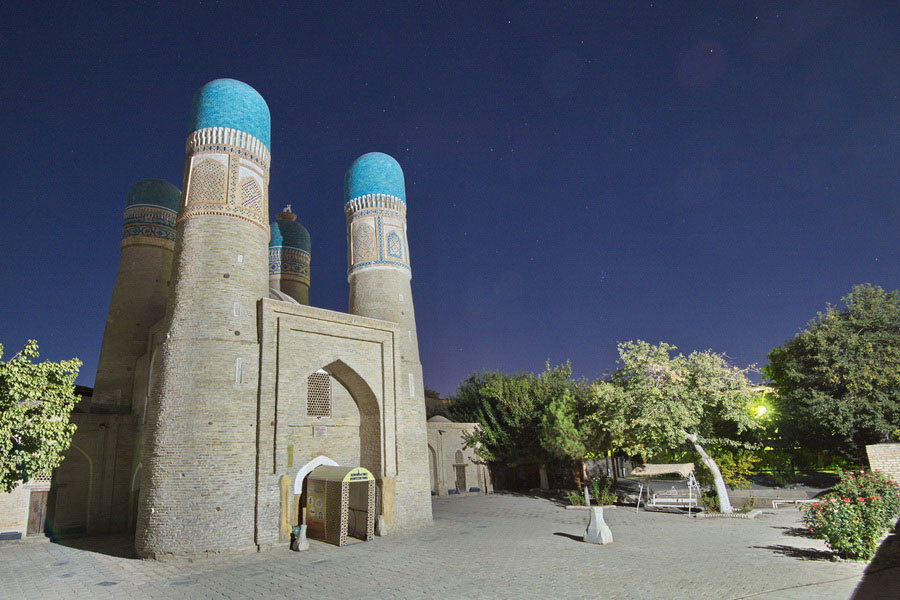
Chor Minor, the Khalifa Niyozkuli Madrasah, was built in 1806. Its name translates to "four minarets," referencing the four identical minarets adorning the building, each topped with a blue dome. Interestingly, each minaret features a distinct decorative style. The designs are often interpreted as symbols of four religions, including the Christian fish, the cross, and the Buddhist prayer wheels.
Chor-Bakr, a necropolis situated near Bukhara, is considered the largest in Central Asia. Known as the city of the dead, it was constructed in the 16th century. Many prominent individuals are interred here, such as Abu Bakr Saad, a descendant of the Prophet Muhammad, who is believed to be among the first buried at the site.
Bukhara also boasts numerous other points of interest, including the Khoja Gaukushon complex, Magoki-Attori Mosque, Mausoleum of Imam Abu Khavs Kabir, Khanaka Mosque of Khoja Zainuddin, medieval baths, and much more.
Bukhara Museums
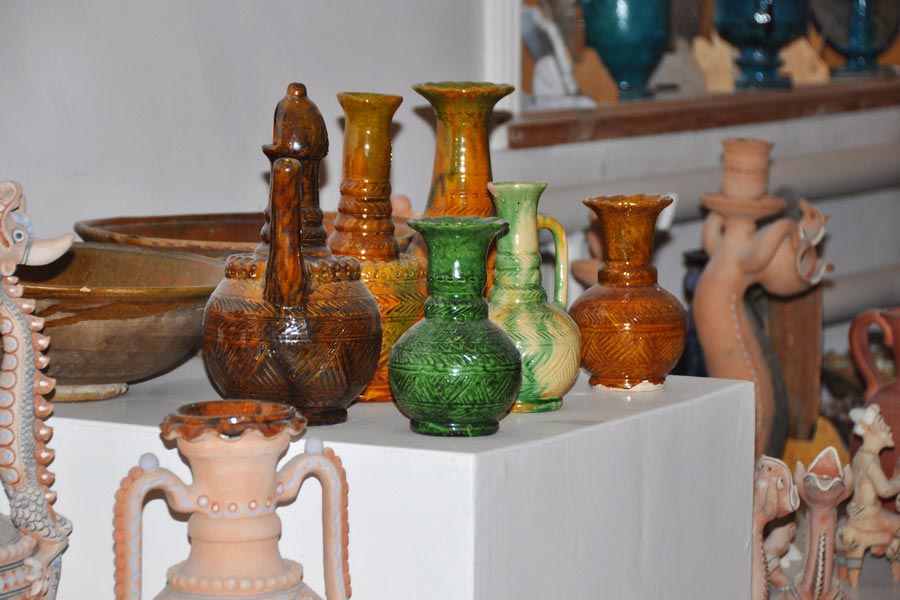
Bukhara is a city of museums, with numerous fascinating collections to explore.
Bukhara State Architectural Art Museum-Preserve, established in 1922, boasts hundreds of exhibits, including documents, photographs, household items, coins, weapons, paintings, sculptures, books, ceramics, jewelry, fabrics, and much more.
Museum of Fine Arts features paintings, graphic art, and sculptures, with the oldest exhibits dating back to the 1st century BC. It also houses fragments of decor from the 6th-7th centuries, as well as works by contemporary artists.
Frequented by visitors, the Faizullah Khojaev House-Museum is situated in the historic Goziyon quarter. Khojaev was a prominent figure who advocated for improving the lives of people in the Bukhara Emirate. He was a leader of the Jadids who was executed in the 1930s. The house-museum displays his personal belongings, documents, photographs, and collections of utensils, furniture, and weapons.
Established in the 1990s, the History Museum of Restoration of Architectural Monuments of Bukhara focuses on the extensive restoration work undertaken in the historical part of Bukhara during the 20th century.
Museum of Carpet Weaving History, founded in 1991, showcases silk and woolen carpets from the 18th to the 21st centuries, originating from Uzbekistan, Iran, Turkmenistan, and Kazakhstan.
The Blacksmith History Forge Museum, situated in the Kuluta caravanserai, offers a glimpse into the history of blacksmithing. Visitors can observe the work of 18th to 21st-century blacksmiths and even participate in creating ironwork themselves.
Workshop-museum of Uzbek puppets is sure to captivate both children and adults. Learn about the doll-making process, marvel at the pumpkin dolls on display, and even purchase a doll as a souvenir or gift.
Located near Bukhara, Gijduvan Ceramics Museum showcases the work of both modern and traditional ceramic masters. The museum features pieces from a family dynasty spanning six generations in the craft.
Romitan Museum of Local History, also near Bukhara, is housed in what was once the winter residence of the Emir of Bukhara. The museum provides insight into Romitan's history and its notable residents.
Located 30 kilometers from Bukhara in the village of Afshana the Abu Ali Ibn Sina Memorial Museum was established in 1980 to commemorate the 1000th anniversary of the renowned physician and scholar, Avicenna. Visitors can learn about his life and scientific contributions at this museum.
Bukhara Theatres
The Bukhara Sadriddin Aini Music and Drama Theater, situated in Mirzo Ulugbek Park, was established in 1921. The theater stages performances in the Uzbek language, drawing from the works of Uzbek classics.
Additionally, Bukhara is home to a puppet theater and summer stages, where local and visiting artists showcase their talents during city festivals.
Entertainment, Parks, and Shopping in Bukhara
Bukhara is a tourist-oriented city, with most attractions clustered around the primary points of interest.
Parks in Bukhara
Although there aren't many parks in the warm climate of Bukhara, the ones that do exist tend to be bustling with activity. Mirzo Ulugbek Park of Culture and Recreation is the most popular, featuring numerous trees, benches, and attractions for children.
Samanid Park of Culture and Recreation is another favorite spot for families with children. Though small, it offers a cozy atmosphere and is located near the central market.
Adjacent to the city administration building (khokimiat), there are two modest parks where retirees and parents with strollers can be found taking leisurely strolls.
A petite park can also be found near the monument to Khoja Nasreddin.
Shopping in Bukhara
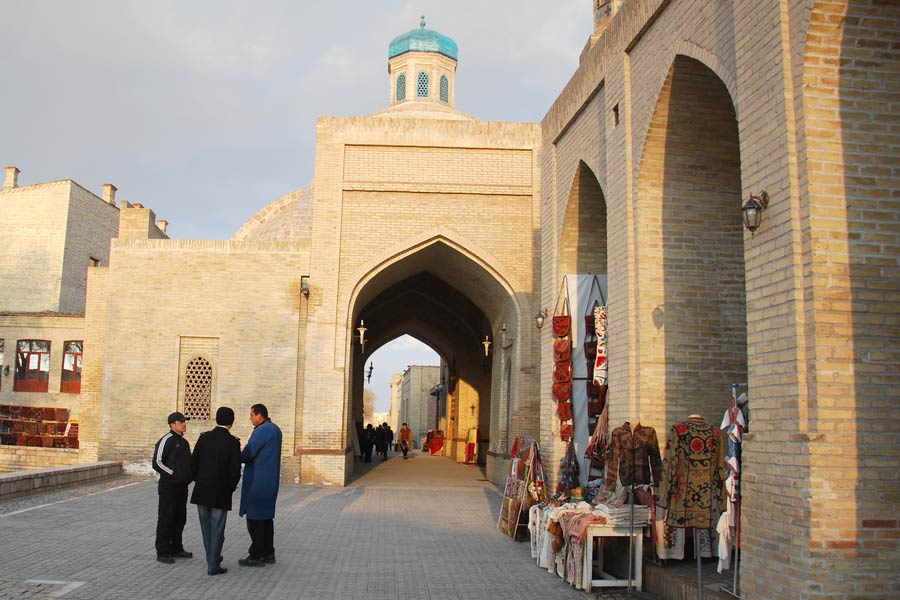
To experience the enticing scents of fresh fruits, delectable sweets, and local culture, head to Buhoro Dehqon Bozori.
For national souvenirs, visit artisan shops in the markets, the Trading Domes of Bukhara, Davron Miniatures Art Gallery, or stalls near popular attractions. Bukhara is renowned for its hereditary craftsmen who create knives, daggers, ceramics, and silver jewelry.
For clothing purchases and family-friendly outings, consider visiting Chinor Mall and Minor.
Food in Bukhara

There are numerous dining options in Bukhara, both in the old center and on the outskirts of the city.
Uzbek Cuisine
The most popular Uzbek dish, plov, can be found at any establishment serving national cuisine. The most delicious plov is said to be prepared at the "Labi hovuz" restaurant. Other Uzbek dishes can be enjoyed at Adras, The Plov, Temir's, Shafran, Ismoil, Old Bukhara restaurants, Xo'ja Nasreddin cafe, and Sham Chaikhana.
Vegetarian Options
While there are no specific vegetarian establishments in Bukhara, meat-free dishes can be found at cafes and restaurants serving Uzbek and Asian cuisine.
Coffee Shops and Bakeries
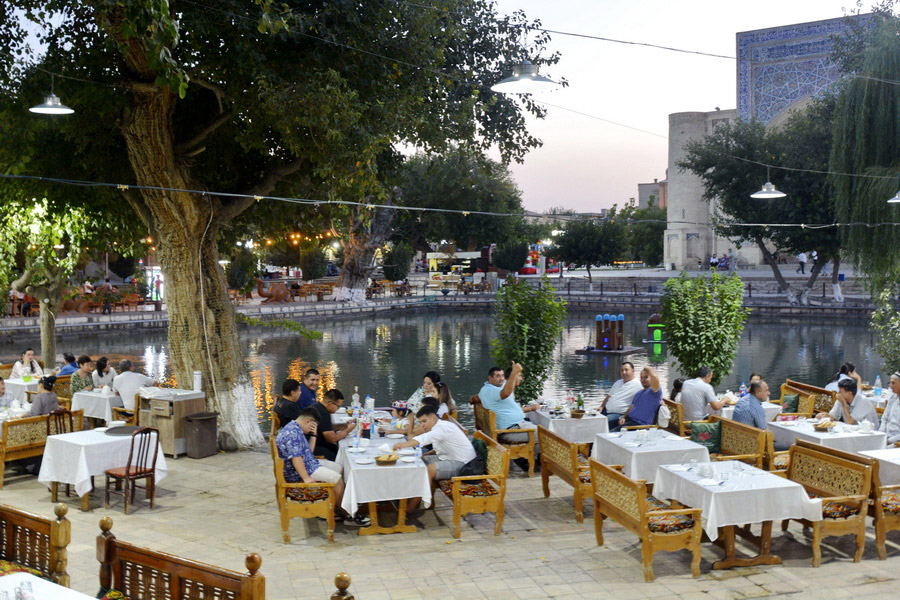
There aren't many coffee shops in Bukhara, but those available are mostly located in the central part of the city. Quality coffee can be found at Coffee&Shop, Magic Coffee, Bella Italia, Tea&Coffee, and Lampa Alladina.
For fresh pastries, visit Bakery Chief and Tea&Coffee.
Transportation in Bukhara
Bukhara has a well-developed public transport system.
Buses
The city has over 30 bus routes, with schedules varying between 06:00 and 21:00, depending on the route. The average wait time for a bus is around 15-20 minutes.
Route taxis
Many Bukhara residents use route taxi. While there are more of them than buses, their schedules are difficult to predict.
Taxis
You can order a taxi through the Yoko Taxi mobile app (only available in Bukhara) or by calling a taxi center. Many people also hail taxis on the street and arrange rides with "private drivers."
Car Rental
Car rental options in Bukhara are limited. There are a few private car rental companies in the city where you can rent standard and business-class cars.
If you want to rent a car in Bukhara, you can book through our trusted partner, Hertz, for top-notch local car rental services.
How to Get to Bukhara
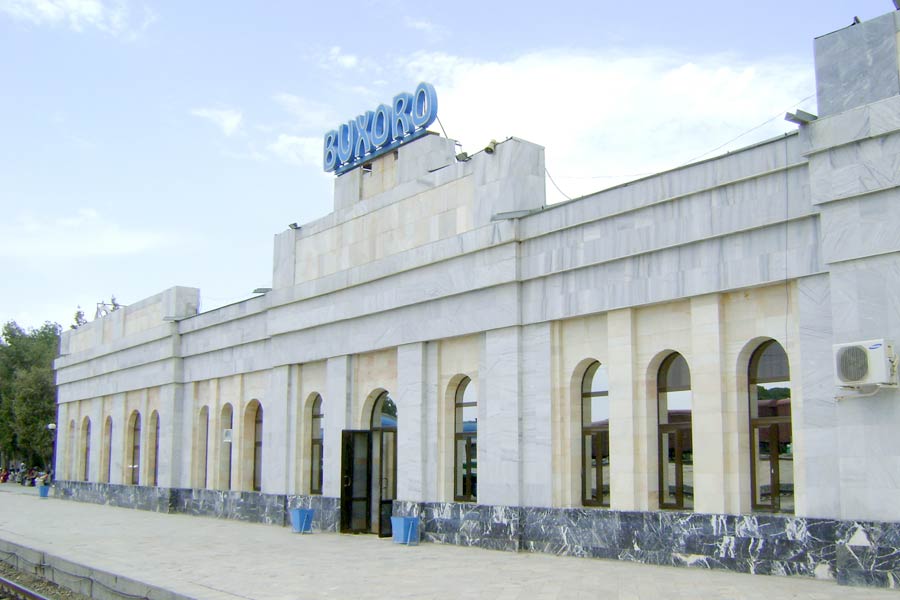
The most convenient way to reach Bukhara is by plane. Bukhara has an international airport serviced by UTair, Azimut, Rossiya, Pobeda, Red Wings, Turkish Airlines, and Uzbekistan Airways. Flights are available from Moscow, St. Petersburg, Istanbul, Yekaterinburg, Makhachkala, Zhukovsky, and Tashkent.
Trains from many cities in Uzbekistan also travel to Bukhara. High-speed train "Afrosiab" connects Tashkent and Samarkand to Bukhara. Note that the railway station is located 15 kilometers from Bukhara, in the small town of Kagan.
Additionally, you can reach Bukhara by bus or private car from various parts of Uzbekistan.
Languages Spoken in Bukhara
Most residents of Bukhara speak Uzbek, the official language of Uzbekistan. Many people also speak Russian, a common language for interethnic communication. English is less widely spoken, but in tourist areas and hotels, you may find people who can communicate in English.
Currency in Bukhara
The national currency of Uzbekistan is the Sum, and all payments in Bukhara are made in this currency. Some places accept international Visa and MasterCard payments, but it's advisable to carry cash. The most popular foreign currencies are the US dollar, followed by the Euro, and then the Russian ruble. Currency exchange is available at any bank branch.
Safety in Bukhara
Bukhara is a relatively safe city with a significant police presence. You can comfortably move around the city during the day and at night. However, always be mindful of your belongings and adhere to basic safety rules.
Bukhara Pictures
More pictures of Bukhara
Night pictures of Bukhara
Winter pictures of Bukhara


